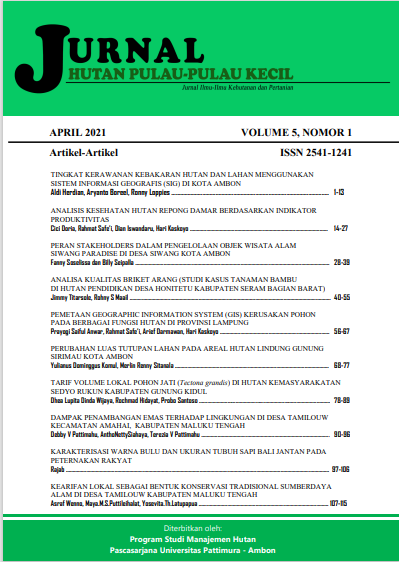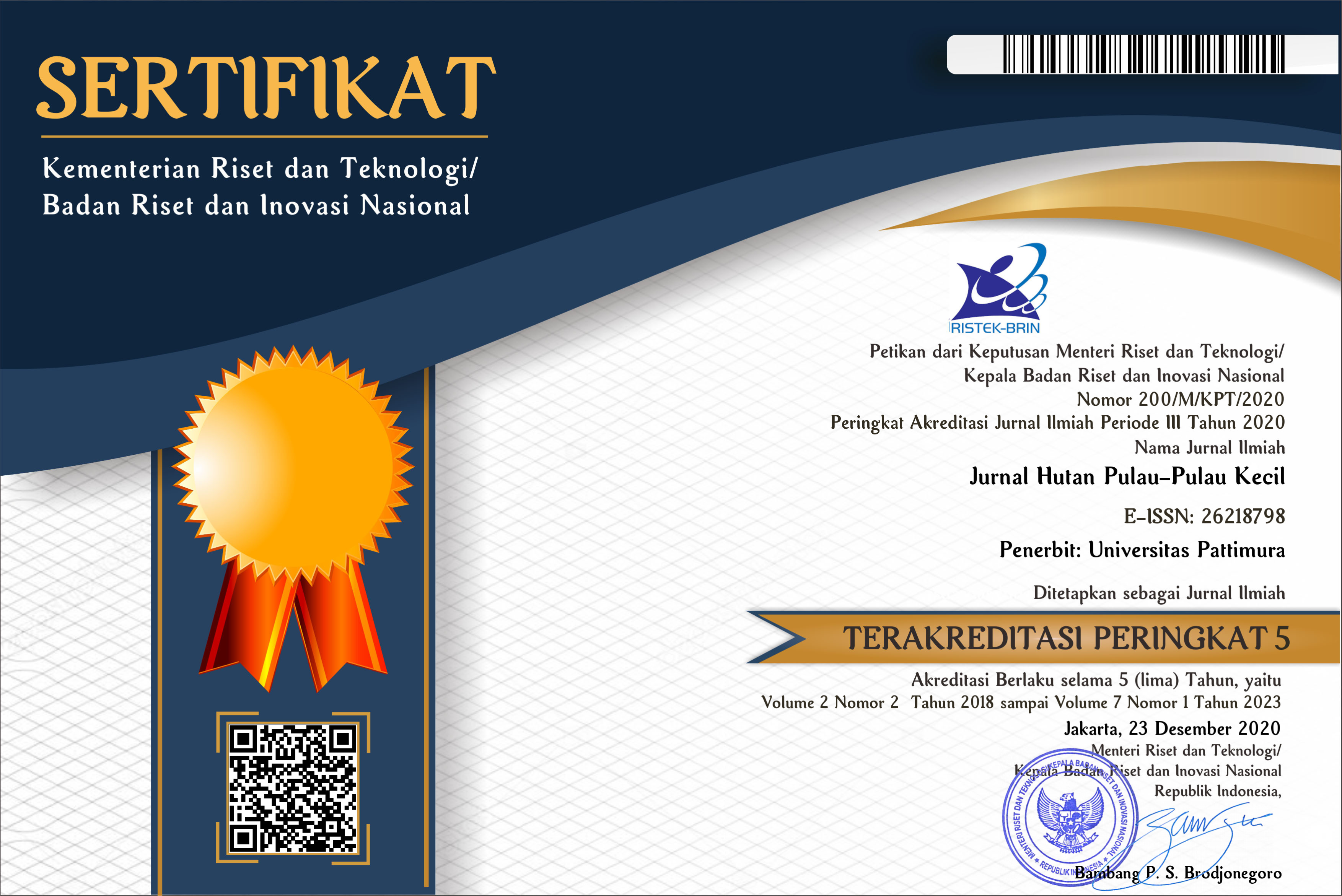PERAN STAKEHOLDERS DALAM PENGELOLAAN OBJEK WISATA ALAM SIWANG PARADISE DI DESA SIWANG KOTA AMBON
Abstract
The potential of the natural tourist attraction of Siwang Paradise will have a high attractiveness value if it is supported by the role of stakeholders in management and development. The purpose of this study is to analyze the role of stakeholders in the management and development of the natural tourist attraction of Siwang Paradise, and what obstacles are experienced by stakeholders in optimally managing and developing these objects. The method used is descriptive qualitative, the determination of respondents is based on snowball sampling technique, the analysis is carried out inductively based on facts and the results of interviews with respondents and key actors. The results showed that the stakeholders involved in the management of the Siwang Paradise object were the key actors (area owners) and the main actors (surrounding communities). Constraints in the management of the Siwang object are due to the lack of trust within the area owner to involve supporting stakeholders, in this case the private sector, NGOs, and academics. So that the management of objects in developing various readiness of tourist attraction products becomes slow and runs not optimally. The visible impact of the management is the economic impact, through increasing family income, social impact, reducing unemployment, opening up road access, making motorcycle taxis easier to use, making it easier for people to do their activities. While the ecological impact is the management is carried out by paying attention to the cleanliness of the environment from waste, and based on the carrying capacity of the object area.
Downloads
References
Berliandaldo M, Chodiq, a., Fryantoni d.,2021. Kolaborasi dan Sinergitas Antar Stakeholder dalam Pembangunan Berkelanjutan Sektor Pariwisata Di Kebun Raya Cibinong. INOBIS: Jurnal Inovasi Bisnis dan Manajemen Indonesia. 4 (2).pp.221-234.
CIFOR. 2004. Pembangunan Pariwisata Berbasis Masyarakat. CIFOR. Bogor.
Damanik J, dan Weber H, 2006. Perencanaan Ekowisata Dari Teori ke Aplikasi. Diterbitkan atas kerjasama dengan Pusat Studi Pariwisata (PUSPAR) UGM dengan Penerbit Andi.Yogjakarta.
Fuqoha, 2021. Analisis Kebijakan Pemerintah Daerah Kota Cilegon Dalam Penetapan Desa Wisata Watu Lawang. Jurnal Administrasi Negara (AsIAN) Vol 9 (1).
Hijriati, E., & Mardiana, R. (2015). Pengaruh Ekowisata Berbasis Masyarakat Terhadap Perubahan Kondisi Ekologi, Sosial Dan Ekonomi Di Kampung Batusuhunan, Sukabumi. Sodality: Jurnal Sosiologi Pedesaan, 2(3), 146–159. https://doi.org/10.22500/sodality.v2i3.
Khomzi, I. R., Handono, S. Y., & Trianawati, A. (2020). Sinergisitas Stakeholder Dalam Pengembangan Desa Wisata Pujon Kidul Kabupaten Malang. Agribusiness Journal, 13(2), 25–35. https://doi.org/10.15408/aj.v13i2.13948.
Latupapua, Y. Th.,2015. Implementasi Peran Stakeholder dalam Pengembangan Ekowisata di Taman Nasional Manusela (TNM) di Kabupaten Maluku Tengah. Jurnal Agroforestri X Nomor 1 ISSN 1907-7556.
Nurkhalis, H.Arief, T.Sunarminto. 2018. Analisis Stakeholders dalam Pengembangan Ekowisata di Hutan Adat Ammatoa Kajang Sulawesi Selatan. Jurnal Pariwisata, Vol. 5 No. 2 September 2018.
Mahfud, M. (2015). Peran Dan Koordinasi Stakeholder Dalam Pengembangan Kawasan Minapolitan Di Kecamatan Nglegok, Kabupaten Blitar. Jurnal Administrasi Publik Mahasiswa Universitas Brawijaya, 3(12), 2070– 2076.
Oktami A.E, Tutut S, dan Harios. A., 2018. Partisipasi Masyarakat Dalam Pengembangan Ekowisata Taman Hutan Raya Ir H Djuanda. Jurnal Media Konservasi Vol. 23 No. 3 Desember 2018: 236-243.
Rizal, A., Sumartik, & Zulfikar. (2017). Analisa Dampak Ekonomi, Sosial, Lingkungan Terhadap Pengembangan Objek Wisata Banyu Biru Di Desa Sumberejo, Winong, Pasuruan Jatim. Forum Manajemen Indonesia (FMI) KE-9, November 2017, ISBN : 978- 602-8557-1-3, 1–14.
Sugiyono. 2011. Metode Penelitian Pendidikan Pendekatan Kuantitatif, kualitatif, dan R&D.Bandung: Alfabeta.
Pamungkas, G. (2013). Ekowisata Belum Milik Bersama: Kapasitas Jejaring Stakeholder dalam Pengelolaan Ekowisata (Studi Kasus: Taman Nasional Gunung Gede Pangrango). Journal of Regional and City Planning, 24(1), 49. https://doi.org/10.5614/jpwk.2013.24.1.4.
Redyanto, F. W., Salahudin, S., & Salviana, V. (2018). Model Kerjasama Antar Stakeholders Dalam Pengembangan Wisata Budaya Dusun Sejo Kabupaten Pasuruan. LOGOS Journal of Local Government Issues, 1–24.
Wakka, Kadir. 2014. Analisis Stakeholders Pengelolaan Kawasan Hutan dengan Tujuan Khusus (KHDTK) Mengkendek, Kabupaten Tana Toraja, Provinsi Sulawesi Selatan. Jurnal Penelitian Kehutanan Wallacea Vol.3 No.1, April 2014 : 47-55.
Wahyono. W.H, Rahmawati D., 2017. Preferensi Stakeholder dalam Pengembangan Ekowisata Mangrove Gunung Anyar Surabaya. Jurnal Teknik ITS Vol. 6, No. 2 (2017), 2337-3520 (2301-928X Print).
https://www.tribunnews.com/regional/2020/09/20 /menikmati-siwang-paradise




